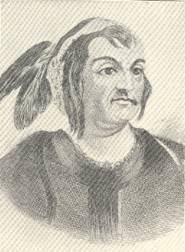
|
|
| Date Published: |
L’Encyclopédie de l’histoire du Québec / The Quebec History Encyclopedia
Tecumseh
Tecumseh (properly Tikamthi or Tecumtha: 'One who passes across intervening space from one point to another,' i.e. 'springs' (Jones); the name indicates that the owner belongs to the gens of the Great Medicine Panther, or Meteor, hence the interpretations 'Crouching Panther' and 'Shooting Star'). A celebrated Shawnee chief, born in 1768 at the Shawnee village of Piqua on Mad r., about 6 m. S. W. of the present Springfield, Ohio. It was destroyed by the Kentuckians in 1780. His father, who was also a chief, was killed at the battle of Point Pleasant in 1774. His mother is said to have been by birth a Creek, but this is doubtful. It must be remembered that a considerable body of Shawnee were
domiciliated among the Creeks until long after the Revolution. On the death of his father, Tecumseh was placed under the care of an elder brother, who, in turn, was killed in battle with the whites on the Tennessee frontier in 1788 or 1789. Still another brother was killed by Tecumseh's side at Wayne 's victory in 1794. While still a young man, Tecumseh distinguished himself in the border wars of the period, but was noted also for his humane character, evinced by persuading his tribe to discontinue the practice of torturing prisoners. Together with his brother Tenskwatawa the Prophet, he was an ardent opponent of the advance of the white man, and denied the right of the Government to make land purchases from any single tribe, on the ground that the territory, especially in the Ohio Valley country, belonged to all the tribes in common. On the refusal of the Government to recognize this principle, he undertook the formation of a great confederacy of all the western and southern tribes for the purpose of holding the Ohio r. as the permanent boundary between the two races. In pursuance of this object he or his agents visited every tribe from Florida to the head of the Missouri r. While Tecumseh was organizing the work in the S. his plans were brought to disastrous overthrow by the premature battle of Tippecanoe under the direction of the Prophet, Nov. 7, 1811. On the breaking out of the war of 1812, Tecumseh at once led his forces to the support of the British, and was rewarded with a regular commission as brigadier-general, having under his command some 2,000 warriors of the allied tribes. He fought at Frenchtown, Raisin River, Ft. Meigs, and Ft. Stephenson, and covered Procter's retreat after Perry's victory on lake Erie, until, declining to retreat farther, he compelled Procter to make a stand on Thames river, near the present Chatham, Ont. In the bloody battle which ensued the allied British and Indians were completely defeated by Harrison, Tecumseh himself falling in the front of his warriors, Oct. 5, 1813, being then in his 45th year. With a presentiment of death, he had discarded his general's uniform before the battle and dressed himself in his Indian deerskin. He left one son, the father of Wapameepto, alias Big Jim. From all that is said of Tecumseh in contemporary record, there is no reason to doubt the verdict of Trumbull that he was the most extraordinary Indian character in Canadian and United States history. There is no true portrait of him in existence, the one commonly given as such in Lossing's War of 1812 (1875) and reproduced in Appleton's Cyclopedia of American Biography (1894), and Mooney's Ghost Dance (1896), being a composite result based on a pencil sketch made about 1812, on which were mounted his cap, medal, and uniform. Back to the Indians of Canada and Quebec page
Source : Geographic Board of Canada , Handbook of Indians of Canada, Published as an Appendix to the Tenth Report of the Geographic Board of Canada, Ottawa , 1913, 632p., pp. 450-451. |
© 2005
Claude Bélanger, Marianopolis College |
|
